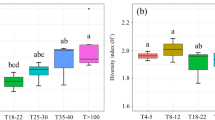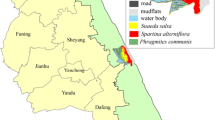Abstract
Plant species dominance and arbuscular mycorrhizas (AMs) were evaluated in four different habitats of Cholistan desert, Pakistan. The sites were selected on the basis of variations in topography, floristic composition and biotic interference. The phytosociological data revealed obvious differences in the floristic composition, plant species diversity, AM colonization and arbuscular mycorrhizal fungi (AMF) spore densities in the rhizospheres. The vegetation pattern and composition was governed by topography and edaphic characteristics of a particular site. Grasses were dominant and main components of vegetation at all the study sites and were invariably mycorrhizal. Some plant species were mycorrhizal at one site but non-mycorrhizal at the other. The AMF survey reported here offers an important starting point from which to analyse AMF community structure in different phytosociological habitats and land uses of Cholistan desert.

Similar content being viewed by others
References
Allen EB, Allen AF (1990) The mediation of competition by mycorrhizae in successional and patchy environment. In: Grace JB, Tilman GD (eds) Perspectives on plant competition. Harcourt Brace Jovanovich, New York, pp 367–389
Auge RM (2001) Water relations, drought and vesicular–arbuscular mycorrhizal symbiosis. Mycorrhiza 11:3–42
Bever JD, Schultz PA, Pringle A, Morton JB (2001) Arbuscular mycorrhizal fungi: more diverse than meets the eye, and the ecological tale of why. Bioscience 51:923–932
Bray EA (1997) Plant responses to water deficit. Trends Plant Sci 2:48–54
Caldwell BA, Jumpponen A, Trappe JM (2000) Utilization of major detrital substrates by dark septate, root endophytes. Mycologia 92:230–232
Carlsen TA (2002) Molecular diversity of root endophytes in an alpine Bistorta vivipara-Kobresiamyosuroides tundra plant community. M.Sc, thesis. Department of Biology, University of Oslo, 53 pp
Carvalho LM, Correia PM, Ryel RJ, Martins-Loucao MA (2003) Spatial variability of arbuscular mycorrhizal fungal spores in two natural plant communities. Plant Soil 251:227–236
Currah RS, Tsuneda A (1993) Vegetative and reproductive morphology of Phialocephala fortinii (Hyphomycetes, Mycelium radicis atrovirens) in culture. Trans Mycol Soc Jpn 34:345–356
Gerdemann JW (1968) Vesicular arbuscular mycorrhiza and plant growth. Annu Rev Plant Phytopathol 6:397–418
Gerdemann JW, Nicolson TH (1963) Spores of mycorrhizal Endogone species extracted from soil by wet sieving and decanting. Trans Br Mycol Soc 46:235–244
Giovannetti M, Mosse B (1980) An evaluation of techniques for measuring vesicular–arbuscular mycorrhizal infection in roots. New Phytol 84:489–500
Hartnett DC, Wilson GWT (2002) The role of mycorrhizas in plant community structure and dynamics: lessons from grassland. Plant Soil 244:319–331
Hirrel M, Mehravaran CH, Gerdemann JW (1978) Vesicular arbuscular mycorrhizae in Chenopodiaceae and Cruciferae: do they occur. Can J Bot 56:2813–2817
Jumpponen A, Trappe JM (1998) Dark septate endophytes: a review of facultative biotrophic root colonizing fungi. New Phytol 140:295–310
Khan AG (1971) Occurrence of Endogone spores in West Pakistan soils. Trans Br Mycol Soc 54:53–63
Khan AG (1974) The occurrence of mycorrhizas in halophytes, hydrophytes and xerophytes, and of Endogone spores in adjacent soils. J Gen Microbiol 81:7–14
Khan AG, Belik M (1995) Occurrence and ecological significance of mycorrhizal symbiosis in aquatic plants. In: Varma A, Hock B (eds) Mycorrhiza: structure, function, molecular biology and biotechnology. Springer, Berlin Heidelberg New York, pp 627–666
Kowalchuk GA, DeSouza FA, VanVeen JJ (2002) Community analysis of arbuscular mycorrhizal fungi associated with Ammophila arsenaria in Dutch coastal sand dunes. Mol Ecol 11:571–581
Kramer PJ, Boyer JS (1997) Water relations of plants and soils. Academic, San Diego
Lamont B (1982) Mechanisms for enhancing the nutrient uptake in plants with particular reference to Mediterranean South Africa and Western Australia. Bot Rev 48:597–689
Lovera M, Cuenca G (1996) Arbuscular mycorrhizal infection in Cyperaceae and Gramineae from natural, disturbed and restored savannas in La Gran Sabana, Venezuela. Mycorrhiza 6:111–118
McGee PA (1989) Variation in propagule numbers of vesicular arbuscular mycorrhizal fungi in a semi-arid soil. Mycol Res 92:28–33
Meney KA, Dixon KW, Scheltema M, Pate JS (1993) Occurrence of vesicular arbuscular fungi in dryland species of Restionaceae and Cyperaceae from south-west Western Australia. Aust J Bot 41:733–737
Muthukumar T, Udaiyan K (2002) Seasonality of vesicular arbuscular mycorrhizae in sedges in a semi-arid tropical grassland. Acta Oecol 23:337–347
Nicolson TH (1960) Mycorrhiza in the Gramineae. II. Development in different habitats, particularly sand dunes. Trans Br Mycol Soc 43:132–145
O'Connor PJ, Smith SE, Smith FA (2001) Arbuscular mycorrhizas influence diversity and structure in a semi-arid plant community. In: Smith SE (ed) Diversity and integration in mycorrhizas. Proceedings of the 3rd International Conference on Mycorrhizas. Kluwer, Dordrecht
Pande M, Tarafdar JC (2004) Arbuscular mycorrhizal fungal diversity in neem-based agroforestry systems in Rajasthan. Appl Soil Ecol 26:233–241
Phillips JM, Hayman DS (1970) Improved procedure for clearing root parasitic and vesicular–arbuscular mycorrhizal fungi for rapid assessment of infection. Trans Br Mycol Soc 55:561–581
Powell CL (1975) Rushes and sedges are non-mycotrophic. Plant Soil 42:481–484
Pringle A, Bever JD (2002) Divergent phonologies may facilitate the co-existance of arbuscular mycorrhizal fungi in a North Carolina grassland. Am J Bot 89:1439–1446
Ruiz-Lozano JM (2003) Arbuscular mycorrhizal symbiosis and alleviation of osmotic stress: new perspectives for molecular studies. Mycorrhiza 13:309–317
Ruiz-Lozano JM, Azcon R, Gomez M (1995) Effects of arbuscular mycorrhizal Glomus species on drought tolerance: physiological and nutritional plant responses. Appl Environ Microbiol 61:456–460
Ruiz-Lozano JM, Collados C, Barea JM, Azcon R (2001) Arbuscular mycorrhizal symbiosis can alleviate drought-induced nodule senescence in soybean plants. New Phytol 151:493–502
Smilauer P, Smilauerova M (2000) Effect of AM symbiosis exclusion on grassland community. Folia Geobot 35:13–25
Smith MR, Charvat I, Jacobson RL (1998) Arbuscular mycorrhizae promote establishment of prairie species in a tallgrass prairie restoration. Can J Bot 76:1947–1954
van der Heijden MGA, Boller TW, Sanders IR (1998) Different arbuscular mycorrhizal fungal species are potential determinants of plant community structure. Ecology 79:2082–2091
Vrålstad T, Myhre E, Schumacher T (2002) Molecular diversity and phylogenetic affinities of symbiotic root-associated ascomycetes of the Helotiales in burnt and metal polluted habitats. New Phytol 155:131–148
Author information
Authors and Affiliations
Corresponding author
Rights and permissions
About this article
Cite this article
Chaudhry, M.S., Batool, Z. & Khan, A.G. Preliminary assessment of plant community structure and arbuscular mycorrhizas in rangeland habitats of Cholistan desert, Pakistan. Mycorrhiza 15, 606–611 (2005). https://doi.org/10.1007/s00572-005-0002-0
Received:
Accepted:
Published:
Issue Date:
DOI: https://doi.org/10.1007/s00572-005-0002-0




